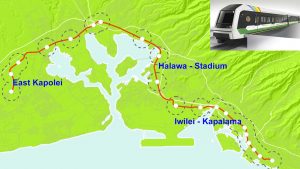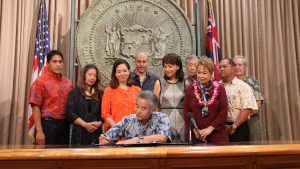The vision: ‘Smart Communities’ near transit hubs
Posted on Feb 26, 2018 in Featured
An O’ahu map shows three priority areas for TOD “Smart Communities” with an illustration of the train.
Revitalized neighborhoods. More affordable housing. Better access to services. And the convenience of the ride. That’s the vision laid out in a new strategic plan from the Hawai‘i Interagency Council for Transit-Oriented Development (TOD). Whether it’s affordable housing along O‘ahu’s rail line or neighbor island rentals along bus lines, the goal is the same: to make the most of state land in designated transit areas.
“TOD remains one of our biggest game changers and will allow us to build affordable homes, direct growth, protect open space and agriculture, and reinvigorate older neighborhoods for the future,” Governor Ige said.
On O‘ahu, the report highlights opportunities for “smart growth” TOD planning because the state is the largest landowner along the 20-mile rail corridor. On the neighbor islands and rural O‘ahu, the report highlights opportunities through Transit-Ready Development (TRD) hubs for pedestrian-friendly streets and connecting people to jobs, schools and services.
Among the opportunities near 21 planned rail stations on O‘ahu are three priority TOD areas named in the report — East Kapolei, Halawa/Aloha Stadium and Iwilei/ Kapalama — in addition to projects already underway in Kaka‘ako. Each area offers an opportunity to shape neighborhoods and increase affordable housing and other community opportunities.
“The TOD Council is looking at every way to move these projects forward,” said Leo Asuncion, state Office of Planning director. “We’re focusing on the gap group of 60 to 140 percent area
median income levels. It’s the gap because there’s really no financing or tax credit incentive (for housing projects) that covers anything above 60 percent from the federal government or the state.”
To make progress, the governor’s capital improvement budget requests this legislative session include:
• $4.5 million for infrastructure improvements at the Mayor Wright Homes site near the Iwilei transit station. The goal is to redevelop the 15-acre site for 2,500 residential mixed-income units, 66 percent of which will be designated affordable.
• $25 million to be set aside from the Rental Housing Revolving Fund for the Alder Street affordable rental housing project near the Ala Moana rail station. The project will include 180 units for households earning 60 percent and below the area median income. The governor is also asking for $25 million statewide for the Dwelling Unit Revolving Fund to help development of affordable rentals and regional infrastructure on O‘ahu, Maui and Hawai‘i with additional requests from Kaua‘i and Maui counties.
